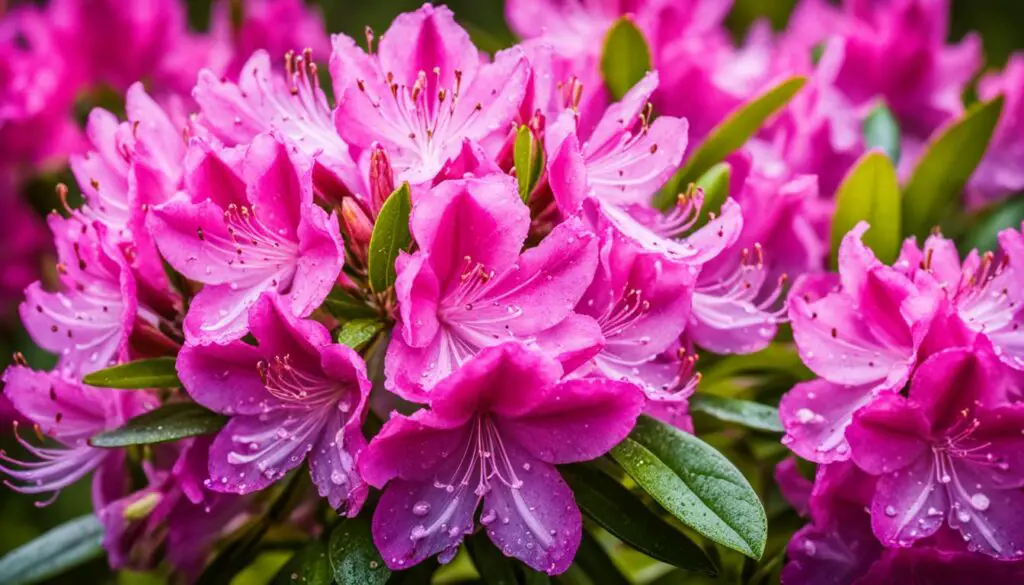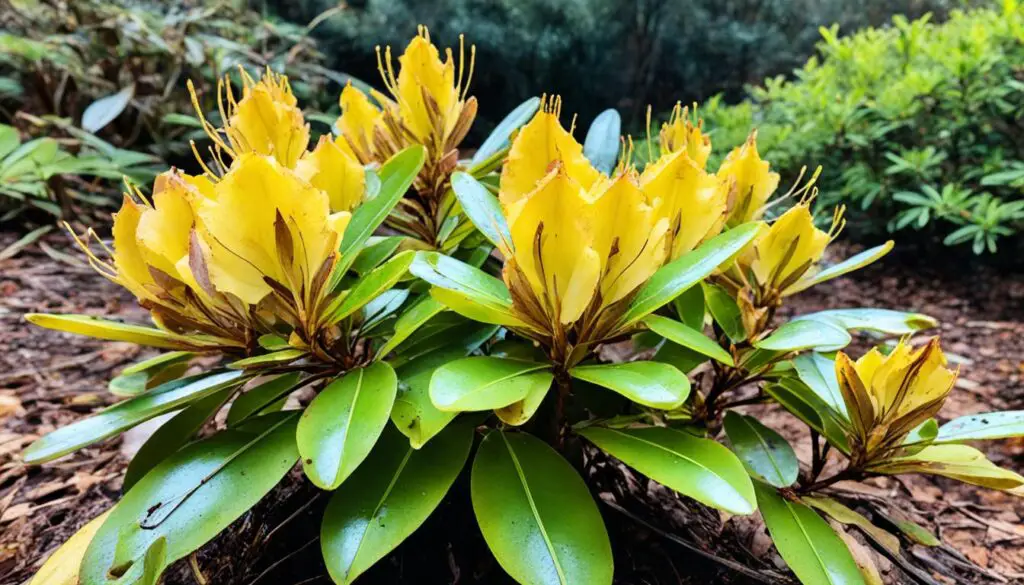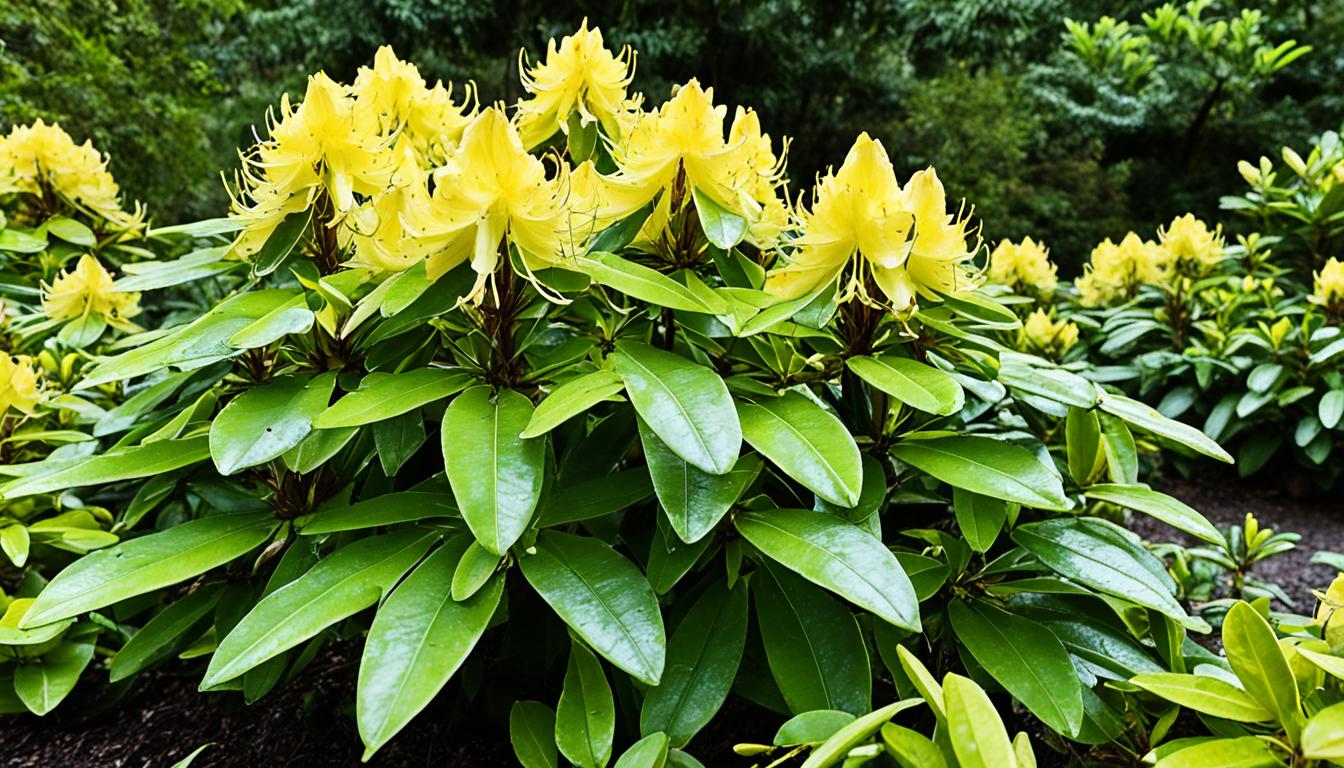Yellow leaves on rhododendron plants can be a cause for concern. Understanding the causes of yellowing leaves is crucial for addressing the issue and restoring the plant’s health. This article will explore the various factors that can contribute to yellow leaves on rhododendrons and provide effective solutions to fix the problem.
Key Takeaways:
- Rhododendrons can develop yellow leaves due to various causes
- Soil acidity and nutrient deficiencies are common culprits
- Diagnosing the specific cause is important for effective solutions
- Adjusting soil pH and applying organic/inorganic amendments can help restore rhododendron health
- Understanding and addressing the underlying issues is crucial for vibrant foliage
Understanding Rhododendrons and Their Soil Preferences

When it comes to cultivating healthy and vibrant rhododendrons, understanding their soil preferences is crucial. These beautiful flowering plants have specific requirements that directly impact their overall health and foliage. In this section, we will explore the importance of soil acidity for rhododendrons and delve into the factors that contribute to ideal soil conditions for promoting healthy foliage.
The Importance of Soil Acidity for Rhododendrons
Rhododendrons thrive in well-draining soil with a slightly acidic pH. Maintaining the correct soil acidity is essential for their overall growth and development. Rhododendrons are known to prefer a soil pH level ranging from 4.5 to 6.0. This acidity level enables the plants to efficiently absorb essential nutrients from the soil, leading to luscious foliage and vibrant blooms.
To ensure the optimal soil acidity for rhododendrons, you may need to test your soil’s pH level. This can be done using a soil testing kit, available at most garden centers or through professional testing services. Adjusting the pH level can be achieved by adding suitable amendments, such as sulfur for lowering pH or lime for increasing pH, following the manufacturer’s instructions and recommended quantities.
Identifying Ideal Soil Conditions for Healthy Foliage
Aside from soil acidity, other factors contribute to the ideal soil conditions required for promoting healthy rhododendron foliage. These considerations include:
- Well-draining soil: Rhododendrons dislike waterlogged soil, which can lead to root rot and other issues. Ensuring proper drainage in the planting area is essential for preventing water accumulation around the roots.
- Organic matter: Rhododendrons benefit from soil enriched with organic matter, such as compost or well-rotted manure. This helps improve soil structure, water retention, and nutrient availability.
- Avoidance of heavy clay soil: Rhododendrons struggle in heavy clay soil due to poor drainage and limited aeration. If you have clay soil, consider incorporating organic matter or creating raised beds to enhance drainage conditions.
By understanding and meeting the soil preferences of rhododendrons, you can create an environment that promotes healthy growth and abundant foliage. The next section will explore potential nutrient deficiencies and their effects on rhododendrons, providing further insights into maintaining the well-being of these stunning plants.
Yellow Leaves on Rhododendron: A Symptom of Underlying Issues

Yellow leaves on rhododendrons can often indicate underlying issues, including nutrient deficiencies. Understanding these underlying issues is crucial for effectively addressing the problem of yellow leaves on rhododendron plants.
Potential Nutrient Deficiencies and Their Effects on Rhododendrons
When rhododendrons experience nutrient deficiencies, it can manifest in the form of yellow leaves. Nutrients such as nitrogen, phosphorus, potassium, iron, and magnesium are essential for the plant’s growth and overall health. Deficiencies in these nutrients can cause yellowing and other symptoms in the leaves.
Here is an overview of the effects of common nutrient deficiencies:
- Nitrogen deficiency: Yellowing starts from the oldest leaves and progresses towards the younger leaves. The leaves may appear pale and stunted.
- Phosphorus deficiency: Leaves may turn purplish or reddish-purple. Growth may be stunted, and the plant may exhibit poor flower formation.
- Potassium deficiency: Older leaves develop yellow or brown spots, and leaf edges may curl or become scorched. The plant may also show weak growth.
- Iron deficiency: Leaves turn yellow while the veins remain green, a condition known as chlorosis. The younger leaves are typically the first to show symptoms.
- Magnesium deficiency: Leaves show yellowing between veins, starting from the bottom of the plant. This is often accompanied by leaf curling.
Iron Deficiency and Chlorosis in Rhododendrons
Iron deficiency is one of the common nutrient deficiencies that can lead to yellow leaves on rhododendrons. When the plant lacks sufficient iron, it cannot produce enough chlorophyll in its leaves, resulting in chlorosis.
Chlorosis is characterized by yellowing of leaves while the leaf veins remain green. The condition affects the younger leaves first, and if left untreated, can progress to affect the entire plant. Rhododendrons with iron deficiency may exhibit weak growth, reduced flower production, and overall poor health.
To address iron deficiency and chlorosis, it is important to adjust the soil pH and provide the necessary iron supplements to the plant.
To better understand the effects of iron deficiency in rhododendrons, refer to the table below:
Diagnosing the Cause of Yellowing in Rhododendron Leaves
Diagnosing the cause of yellowing in rhododendron leaves requires a careful assessment of various factors. By understanding the potential causes behind the yellowing, it becomes easier to identify the underlying issue and proceed with appropriate solutions to restore the plant’s health.
When examining yellowing rhododendron leaves, it is important to consider the following:
- Environmental factors: Evaluate the growing conditions such as sunlight exposure, temperature fluctuations, and humidity levels. Extreme conditions can stress the plant and lead to leaf yellowing.
- Watering practices: Overwatering or underwatering can contribute to yellow leaves. Ensure proper drainage and adjust watering frequency to maintain optimal moisture levels.
- Soil conditions: Test the pH level to determine if the soil acidity is within the appropriate range for rhododendrons. Imbalances can hinder nutrient uptake and lead to yellowing.
- Nutrient deficiencies: Assess the plant’s nutrient levels, including major elements like nitrogen, phosphorus, and potassium, as well as micronutrients like iron and magnesium. Deficiencies can cause leaf yellowing as the plant struggles to perform essential functions.
- Pest and disease infestations: Examine the leaves for signs of pests or diseases, such as aphids, mites, or fungal infections, which can weaken the plant and result in yellowing foliage.
Utilizing a systematic approach to diagnose the cause of yellowing in rhododendron leaves allows gardeners to pinpoint and address the specific issue efficiently. Conducting soil tests, inspecting the leaves, and considering environmental factors are crucial steps in the diagnosis process.
To assist in the diagnosis, refer to the image below, which showcases common symptoms associated with various causes of yellowing in rhododendron leaves:
| Cause | Symptoms |
|---|---|
| Environmental stress | Yellowing, wilting, leaf drop |
| Overwatering | Yellowing, leaf tip browning, root rot |
| Underwatering | Yellowing, leaf curling, dry soil |
| Soil acidity imbalance | Yellowing between veins, stunted growth |
| Nutrient deficiencies | Yellowing, chlorosis, leaf discoloration |
| Pest or disease infestation | Yellowing, spots, visible pests |
This comprehensive table outlines the symptoms associated with different causes of yellowing in rhododendron leaves. By comparing the observed symptoms to those in the table, gardeners can narrow down the potential cause and proceed with the appropriate diagnosis.
Practical Solutions to Restore Rhododendron Health
Restoring the health of rhododendrons requires practical solutions that address the underlying issues causing yellow leaves. By implementing the following steps, you can effectively restore the health and vibrancy of your rhododendron plants.
How to Adjust Soil pH for Optimal Nutrient Absorption
One of the key factors in rhododendron health is the pH level of the soil. Rhododendrons prefer acidic soil with a pH range between 4.5 and 6.0. If the soil pH is too high or too low, it can hinder the plant’s ability to absorb nutrients properly, leading to yellowing leaves.
To adjust the soil pH:
- Conduct a soil pH test using a soil testing kit, available at garden centers or online.
- If the pH is too high (alkaline), add elemental sulfur to the soil. Follow the package instructions for the recommended amount based on your soil’s pH level.
- If the pH is too low (acidic), add agricultural lime to the soil. Again, consult the packaging for the appropriate application rate.
- After applying the necessary amendments, mix them into the soil thoroughly.
- Re-test the soil pH after a few weeks to ensure it has reached the desired range.
By adjusting the soil pH to the optimal range, you can promote better nutrient absorption and prevent yellow leaves on your rhododendron plants.
Organic and Inorganic Amendments for Nutrient Recovery
In addition to adjusting soil pH, incorporating organic and inorganic amendments into the soil can help restore nutrient balance and improve rhododendron health. These amendments provide essential nutrients and improve soil structure for better nutrient absorption by the plants.
Organic amendments:
- Compost: Adding compost to the soil enriches it with organic matter, improves soil structure, and enhances nutrient availability.
- Well-rotted manure: Manure is a rich source of nutrients that can replenish the soil and promote healthy growth.
- Leaf mold: Using decomposed leaves as a soil amendment adds organic matter, improves moisture retention, and enhances nutrient availability.
Inorganic amendments:
- Slow-release fertilizers: These granular fertilizers provide a controlled release of nutrients over time, ensuring consistent nourishment for the rhododendron plants.
- Water-soluble fertilizers: Dilute water-soluble fertilizers in water and apply them to the soil as per the packaging instructions for quick nutrient absorption.
- Micronutrient supplements: Certain micronutrients, such as iron, may be deficient in the soil. Use micronutrient supplements to address specific nutrient deficiencies.
When applying amendments, follow the recommended rates provided on the packaging and mix them into the soil around the base of the rhododendron plants. Regularly monitor the plant’s response and adjust the application if necessary.
By incorporating organic and inorganic amendments into the soil, you can enhance nutrient availability and promote the recovery of your rhododendron’s health.
| Soil pH | Nutrient Availability |
|---|---|
| Below 4.5 | Nutrient toxicity, reduced nutrient uptake |
| 4.5 – 6.0 (Ideal Range) | Optimal nutrient availability and uptake |
| Above 6.0 | Nutrient deficiencies, reduced nutrient uptake |
Understanding the relationship between soil pH and nutrient availability is essential for maintaining a healthy rhododendron. Adjusting the soil pH and incorporating appropriate amendments can help restore the plant’s health and prevent yellowing leaves.
Conclusion
In conclusion, the presence of yellow leaves on rhododendron plants is often a sign of underlying issues that need to be addressed. Soil acidity, nutrient deficiencies, and other factors can contribute to this problem. However, by understanding the causes and implementing the appropriate fixes, it is possible to restore the health and vibrancy of rhododendron foliage.
Throughout this article, we have explored the various factors that can cause yellow leaves on rhododendrons. We have discussed the importance of soil acidity and identified the ideal soil conditions for healthy foliage. We have also examined the potential nutrient deficiencies, specifically iron deficiency and chlorosis, that can lead to yellowing leaves.
To diagnose the specific cause of yellowing in rhododendron leaves, a careful assessment of various factors is necessary. By following the guidelines outlined in this article, readers will be able to identify the underlying issue and proceed with appropriate solutions to restore their rhododendron plants’ health.
With the information and solutions provided, readers will be equipped to effectively address yellow leaves on their rhododendron plants. By adjusting soil pH for optimal nutrient absorption and utilizing organic and inorganic amendments for nutrient recovery, it is possible to revitalize the rhododendron plant and restore its vibrant foliage. Remember, a healthy rhododendron with green leaves is within reach.
